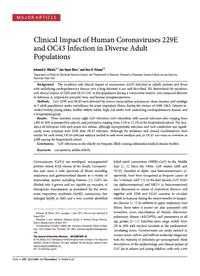
2013 Clinical Impact of Human Coronaviruses 229E and OC43 Infection in Diverse Adult Populations PDF
Preview 2013 Clinical Impact of Human Coronaviruses 229E and OC43 Infection in Diverse Adult Populations
M A J O R A R T I C L E Clinical Impact of Human Coronaviruses 229E and OC43 Infection in Diverse Adult Populations Edward E. Walsh,1,2 Jae Hyun Shin,1 and Ann R. Falsey1,2 1Department of Medicine, Rochester General Hospital; and 2Department of Medicine, University of Rochester School of Medicine and Dentistry, Rochester, New York Background. The incidence and clinical impact of coronavirus (CoV) infection in elderly persons and those with underlying cardiopulmonary disease over a long duration is not well described. We determined the incidence and clinical impact of 229E and OC43 CoV in this population during 4 consecutive winters, and compared illnesses to influenza A, respiratory syncytial virus, and human metapneumovirus. Methods. CoV 229E and OC43 were detected by reverse transcription polymerase chain reaction and serology in 4 adult populations under surveillance for acute respiratory illness during the winters of 1999–2003. Cohorts in- cluded healthy young adults, healthy elderly adults, high-risk adults with underlying cardiopulmonary disease, and a hospitalized group. Results. Three hundred ninety-eight CoV infections were identified, with annual infection rates ranging from 2.8% to 26% in prospective cohorts, and prevalence ranging from 3.3% to 11.1% in the hospitalized cohort. The inci- dence of infections with each strain was similar, although asymptomatic infection and viral coinfection was signifi- cantly more common with 229E than OC43 infection. Although the incidence and clinical manifestations were similar for each strain, OC43-infected subjects tended to seek more medical care, as OC43 was twice as common as 229E among the hospitalized cohort. Conclusions. CoV infections in the elderly are frequent, likely causing substantial medical disease burden. Keywords. coronavirus; adults; elderly. Coronaviruses (CoVs) are enveloped, nonsegmented positive strand RNA viruses of the family Coronaviri- dae and cause a wide spectrum of illness including respiratory and gastrointestinal disease in a variety of mammalian species including humans [1]. CoVs are divided into 4 genera and are capable on occasion of interspecies transmission, as postulated for the severe acute respiratory syndrome (SARS) coronavirus that emerged briefly in 2003 and a very recently identified lethal novel coronavirus (MERS-CoV) in the Middle East [2, 3]. Since the 1960s, CoV strains 229E and OC43, classified as alpha- and betacoronaviruses, re- spectively, have been recognized as frequent causes of the “common cold” [4]. In the past decade, CoV NL63 (an alphacoronavirus) and HKU1 (a betacoronavirus) were discovered as causes of respiratory illnesses and together with 229E and OC43 continue to circulate widely in humans during the winter months in temper- ate climates [5–7]. In addition to upper respiratory tract illness, these latter 4 strains are also associated with bronchitis, acute exacerbation of chronic obstructive pulmonary disease (AECOPD), and pneumonia in all age groups [8–11]. Infection rates range widely from 2% to 20% with marked variation in the predominant circulating strain. Coronaviruses are rarely isolated in routine tissue culture and without molecular diagnostic tests the majority of infections go unrecognized. Most descriptions of the epidemiology and clinical impact of CoV are in infants and young children, with only a few Received 28 March 2013; accepted 7 June 2013; electronically published 6 August 2013. Presented in part: Infectious Diseases Society of America Annual Meeting, Boston, Massachusetts, October 2011. Correspondence: Edward E. Walsh, MD, University of Rochester School of Medi- cine, 1425 Portland Ave, Rochester, NY 14621 (
